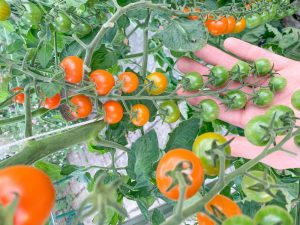Alpine seed sowing compost mix

I recently wrote a post which explained how I sow alpine seeds. I mentioned that I use my “Alpine seed sowing mix” for this, but I didn’t say how to make it. It’s a really simple mix to “knock up”, so here it is.
Recycled fine coir – 2 parts by volume
Mole hill soil (or John Innes No.2) – 1 part by volume
Alpine/horicultural grit – 1 part by volume
Coarse perlite – 1 part by volume
Each component has pros and cons. When creating a compost blend, it’s important to get the proportions right so you get as much of the benefits and as few of the drawbacks from each ingredient.
Now I’m going to briefly explain what each ingredient is and why it’s in the mix.
Recycled fine coir (2 parts)
One of my clients is a compost manufacturer, so they have a lot of recycled coir. They kindly gave me quite a lot and I use it for growing plants in. But for my alpine seed sowing mix, I prefer to blend it with other materials.
If you can’t get a hold of recycled coir, new coir would also work. Just make sure it’s the finer grade stuff rather than the very fibrous stuff.

In this mix, the coir helps to retain water while remaining well aerated. It also helps to break up any clods of soil.
I use coir instead of peat because it’s far more sustainable.
Mole hill soil (1 part)
Most alpine growers would probably use John Innes compost instead of this. But I use mole hill soil to save money and because it’s more sustainable.
I get this product by taking soil from mole hills (it’s in the name). I look for molehills that have dark soil which indicates a high organic matter content. The soil should also be quite free flowing and easy to handle.
Of course, this component is going to have a high degree of variability, but so does John Innes compost
We’re not making a Swiss watch; a bit of variability is fine.


In this compost mix, the mole hill soil aids in moisture retention and rewetting. It also adds weight to the mix which helps to prevent the pots from blowing over in the wind.
Alpine/horticultural grit (1 part)
Alpine, or horticultural grit is found in most alpine compost blends. It improves drainage when the particles link together and create large pore spaces between them.
Grit also reduces the total water holding capacity of the growing media. This is helpful as alpines often grow in rocky soils with low water holding capacity.

Grit gives the added benefit of stopping the pots from blowing over in the wind (it’s very heavy).
NB: Grit is also used as a topdressing to keep the seeds at soil level while germinating.
Coarse perlite (1 part)
Perlite is a valuable component in many potting mixes. It shares some of the same benefits as alpine/horticultural grit, however it’s much lighter and holds more air.
It’s light weight makes it much easier to transport (this also reduces the cost of perlite compared to grit).

Perlite’s light weight is also beneficial when it comes to pricking out seedlings. Lighter compost results in less transplanting shock. This is because heavier compost increases the likelihood of snapping roots during pricking out.
Perlite is also slightly porous which increases the amount of air and water in the pot.



